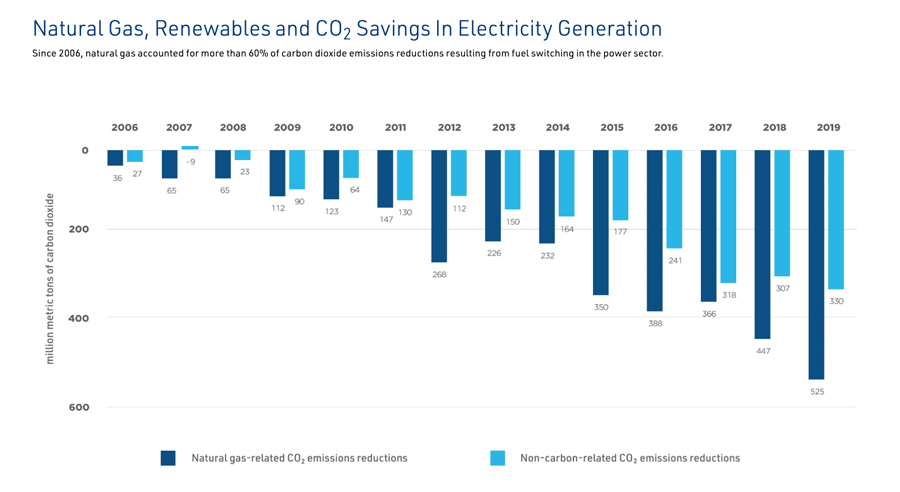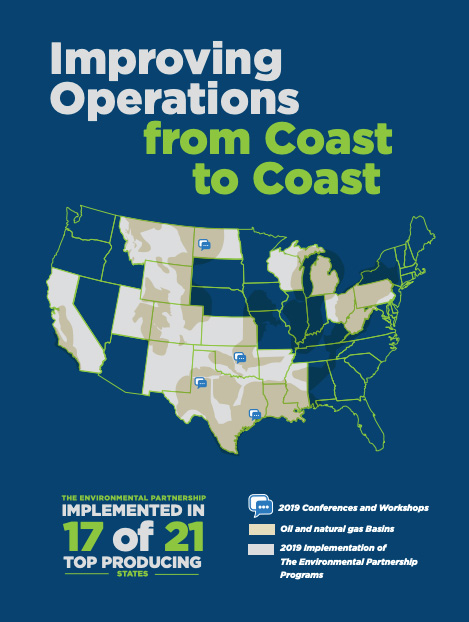Environmental
The natural gas and oil industry is committed to responsible environmental stewardship while it reliably delivers affordable energy and products to consumers. This includes support for public policies that address the risks of climate change, using technology to reduce greenhouse gas emissions and minimize the industry’s environmental footprint.
Jump to:
Climate Strategy and Risk Management
API and its members support public policy approaches that reduce greenhouse gas emissions in a meaningful way, economy wide, while ensuring that consumers have access to affordable, reliable and cleaner energy, including natural gas and oil byproducts.
These approaches must be market-based, balance economic, environmental and energy security needs, eliminate redundant or contradictory policies, and ensure associated costs and benefits are fully transparent to the American public.
API’s Climate Principles guide its positions on public policies that address the risks of climate change and are endorsed by API’s members.
Innovation and Technology
The natural gas and oil industry has driven innovation since its inception and continues to enable progress through life-changing ideas and solutions. For most companies, innovation is a central aspect of their operations, culture and mission.
Companies are constantly investing in new technologies and techniques that advance safety and environmental performance, some of which could deliver feasible, enduring climate solutions – helped by partnerships with scientists, academics, startups and small business owners. For instance, some companies partnered with NASA to develop fiber optic sensing systems that help make offshore drilling platforms safer, while others have partnered with universities for ideas and collaboration that result in commercial projects.
API and its member companies embrace the high-tech innovations that help minimize industry’s environmental footprint and are critical to achieving the ambitions of the Paris Climate Agreement, while shaping the future of energy. In many cases, API members are at the forefront of bringing such technologies to life through the API standards development process, which uses data- and consensus-driven process to standardize techniques and technologies. Our work helps the industry invent and manufacture superior products consistently, provide critical services, and ensure fairness in the marketplace for businesses and consumers alike. These include end-use technologies such as carbon capture, utilization and storage (CCUS). This groundbreaking technology removes carbon dioxide from industry operations – and even directly from the air – and converts it into marketable commodities or recycles it for use in enhanced oil recovery.
Greenhouse Gas Emissions
More than two-thirds of America’s energy demand is met by natural gas and oil, and natural gas remains the leading fuel for U.S. power generation, accounting for about 38% of the nation’s electricity in 2019. Natural gas emits half the carbon dioxide of coal, and coal-to-natural gas switching in power generation has been instrumental in driving energy-related carbon dioxide emissions to their lowest levels in a generation. No other nation has reduced greenhouse gas emissions more than the U.S. since 2000, according to the International Energy Agency.

Methane Emissions and Flaring
Any discussion of addressing the risks of climate change should include a focus on reducing methane emissions from natural gas and oil production. While affordable, reliable energy provided by natural gas and oil is essential to our modern economy and Americans’ everyday lives, lowering methane emissions from that production is a top priority.
In addition to supporting methane emissions reductions through cost-effective public policy, our industry is advancing technology and innovation through industry-led initiatives. Industry actions have reduced methane emissions rates – emissions relative to production – nearly 70% in five of the largest producing regions in the U.S. between 2011 and 2019, according to data from EPA and the U.S. Energy Information Administration.


The Environmental Partnership, a voluntary industry initiative that includes 36 of the top 40 U.S. natural gas producers, is focused on bringing down emissions. It also launched a Flare Management Program for upstream operators, underscoring the commitment to further reduce emissions and improve the industry’s environmental performance.
Additionally, the Environmental Partnership provides funding for the Methane Emissions Technology Evaluation Center (METEC) at Colorado State University, where researchers develop and assess methane sensing technologies.
Air Quality
The natural gas and oil industry supports retaining the EPA’s current National Ambient Air Quality Standards (NAAQS) for ozone, which have contributed to lower emissions and better air quality in the U.S.
Between 1970 and 2019, according to EPA data, the combined U.S. emissions of six common pollutants dropped by 77%, due, in part, to provisions in the Clean Air Act. The industry continues to support a smart, common-sense regulatory approach that protects communities, workers and the environment while also allowing the safe and responsible energy production needed to power a modern economy.
Water Quality
Drilling oil and natural gas wells, pumping oil from the wells, refining crude oil, transportation of crude oil or refined product and operation of filling stations require the responsible management and use of water. Ongoing compliance with environmental laws and regulations that protect rivers, lakes, wetlands and oceans, as well as the groundwater resources, is a vital responsibility of the industry.
API advocates for rules that protect resources based on sound science and are also workable from a compliance perspective. For example, API participates in efforts establishing technically sound and achievable criteria and standards for nutrients such as nitrogen and phosphorus, organic chemicals and metals, as well as determining whether mixing (dilution) zones should be allowed in calculating permit limits for pollutants that bioaccumulate. API also manages issues concerning effluent guidelines – or national limits set on the basis of water treatment technology performance – and issues pertaining to spill prevention, containment, control and response.
Beyond these considerations, API and its member companies are engaged in efforts concerning sustainable water use and energy consumption associated with water use.
In all of these endeavors, API, and the natural gas and oil industry, have worked with governments, universities, and other stakeholder groups to conduct research, share information, and adopt best practices. API and its member companies are dedicated to our responsibility as corporate citizens to minimizing the impacts of energy production, transportation, and use; to improving environmental performance; and to protecting human health and aquatic life.
API Climate Change and Energy Programs, Standards and Events
| API Programs | Key API Standards & Documents | API Forums/Events |
|---|---|---|
|
|
|
API Environmental Programs, Standards and Events
| API Programs | Key API Standards & Documents | API Forums/Events |
|---|---|---|
|
|
|
Additional Resources
Climate Change and Energy
- The Environmental Partnership: Annual Report 2020
- International Organization for Standardization (ISO), 2011: ISO 50001:2011 - Energy management systems: Requirements with guidance for use
- Oil & Gas Methane Partnership (OGMP), 2020: The OGMP Reporting Framework 2.0
- World Economic Forum (WEF), 2019: How to Set Up Effective Climate Governance on Corporate Boards Guiding principles and questions


